Your basket is currently empty!
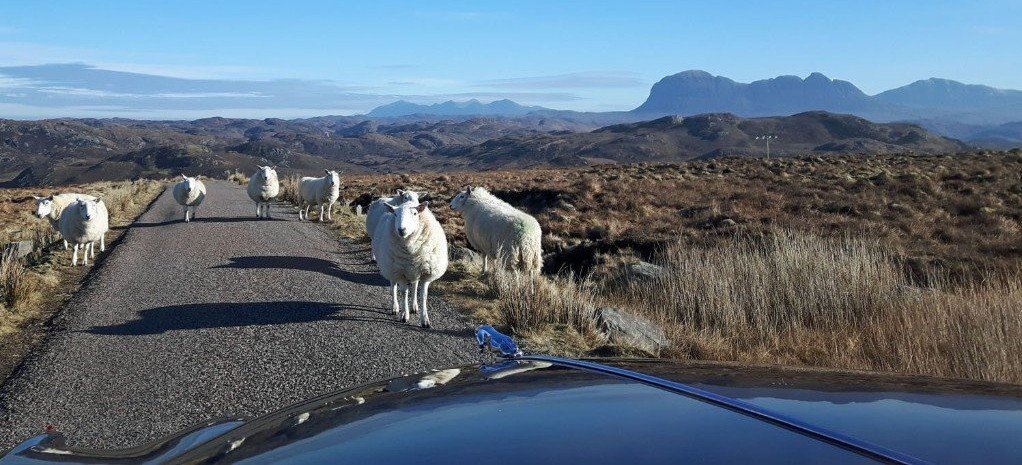

This is a much abridged version of a chapter in my book The Curved Road.
This version below is confined mostly to the route (for your information) and not the experiences we had along the way! Scroll to the end for a breakdown of mileages and waypoints on the route.
In recent years a route known as the North Coast 500 (NC500) has been widely marketed and become hugely popular. Initially devised to promote tourism in the northern Highlands, it has proved highly successful, partly due to the magnificent scenery and partly due to its name – people simply love something that sounds like a challenge.
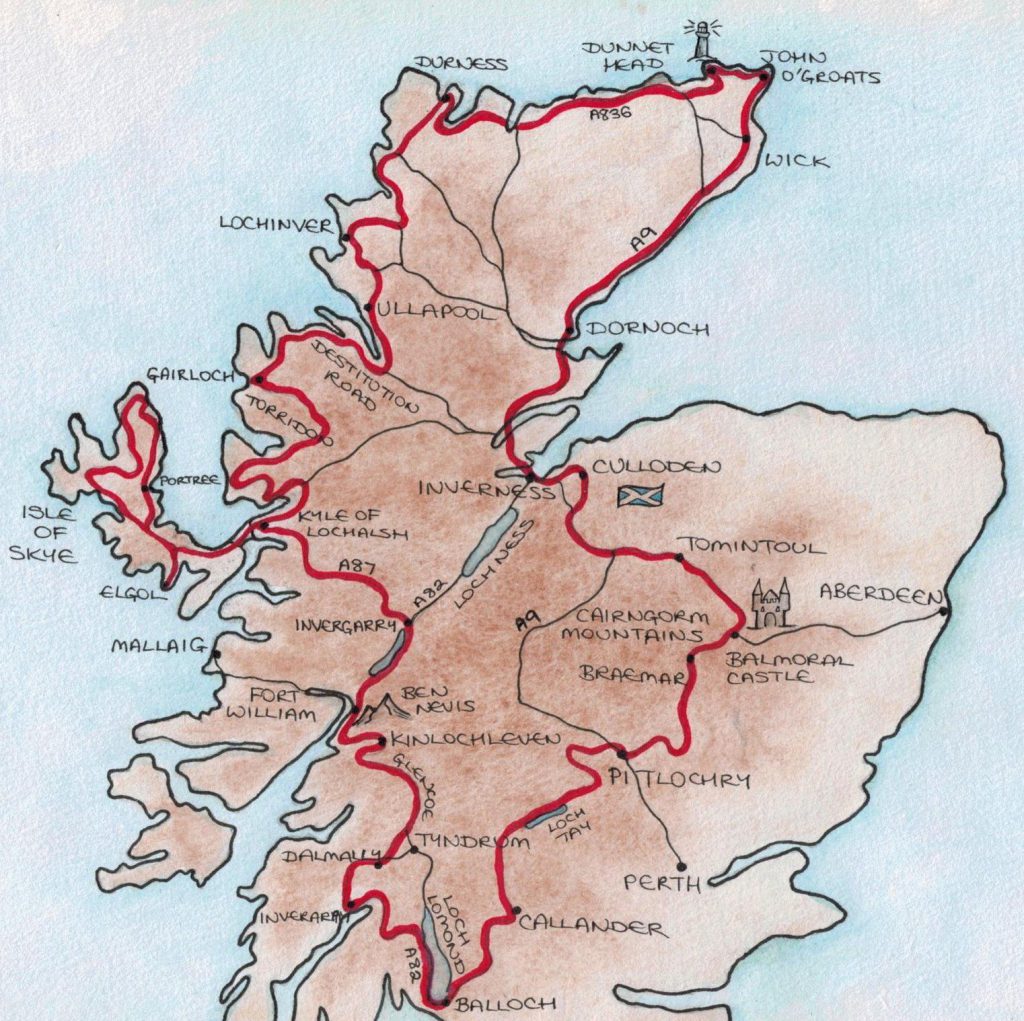
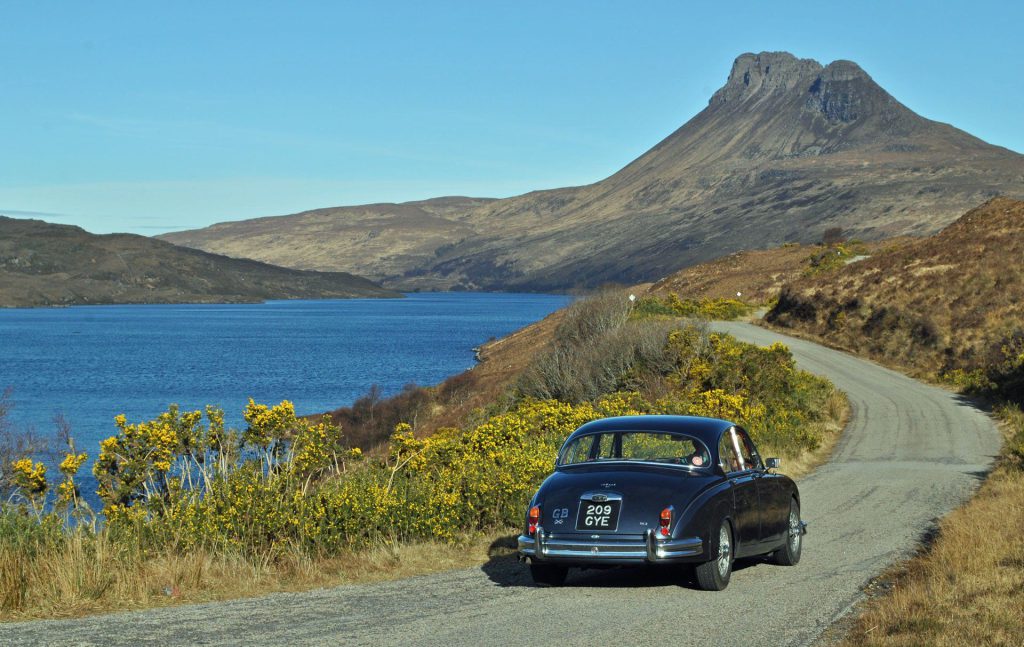
The NC500 begins and ends at Inverness, however, much magnificent landscape lies south of that starting point, so I thought the route could be profitably extended without actually covering much additional mileage. I chose to begin the tour at the southern shores of Loch Lomond, a much more easily accessible starting point where the lowlands meet the highlands. Commencing and concluding at Balloch, the circular tour features all the fabulous coastal sections of the NC500 and adds many additional highlights such as Glencoe, the Isle of Skye, the Cairngorms and the Trossachs.
Leaving Balloch Pier our route heads west from the mid-point of Loch Lomond and across the ‘Rest & Be Thankful’ Pass (heavily snowbound on our visit!). We descended around the head of Loch Fyne (the longest sea loch in Scotland at over 40 miles) and through the picturesque 18th century village of Inveraray. The road swung north to Loch Awe (the longest freshwater loch at 25 miles) before we followed the delightful single track road through Glen Orchy to emerge amidst the wilds of Rannoch Moor. This is a desolate landscape in any season but today was sea of white through which a dark ribbon of lonely road witnessed the passage of a 3.4 litre Jaguar and its spellbound occupants. Entering the wild slice of mountain grandeur that is Glencoe we stopped for the umpteenth time to take photographs (we took over 1,000 on the whole trip). Our route then took the old road around Loch Leven and soon we arrived at Fort William, our overnight halt, the clouds fully clearing to produce a bitterly cold night at -10C.

With blue skies overhead we took a detour deep into Glen Nevis beneath Ben Nevis, Britain’s highest mountain at 4406ft, for an early morning photoshoot, before returning through Fort William and following the quiet roads alongside the Caledonian Canal. This is a lovely drive and far superior to the main road, which is regained at Spean Bridge where an emotive memorial, commemorating the district as a war-time Commando training area, stands proudly observing the lofty mountains. Heading north to Invergarry, then west through the mighty heights of Glen Shiel, we traversed fast roads where the Mk2 was unleashed despite the threatening walls of packed snow at the roadside. As we reached the sea, the snow began to disperse and at last it felt like spring was in the air. As the sun glinted off Loch Duich we encountered Eilean Donan Castle, perhaps the most iconic fortress in the Highlands.
The afternoon drew on and it was time to cross over the sea to Skye, these days reached by an impressive bridge, built as a high graceful arch framing the mountains beyond. Once on the island we chose to extend the day with a detour to Elgol, a magnificent vantage point to view the jagged Black Cuillin, Skye’s immensely impressive mountain range. Skye is a sizeable island but our route concentrated on the mountainous central and northern districts. Above the hamlet of Staffin is a detour not to be missed, a narrow road climbing high into the hills of the Quiraing amidst primeval rock formations. Not until late afternoon could we drag ourselves off Skye, with much ground still to cover as we followed the coast past the astonishing sight of palm trees at Plockton (a benefit of the relatively warm Gulf Stream currents). At Loch Carron we joined the NC500, it having travelled across country from Inverness. Climbing high, we surmounted the famous Bealach na Ba, better known when translated from the Gaelic as the Pass of the Cattle. This road rises to an uncompromising 2,050ft elevating us once again above the snowline and revealing a breathtaking prospect back across to Skye, which made concentration difficult on the narrow road as we descended to Applecross, our next overnight halt.
The Torridon area was the focus of the morning, truly a connoisseur’s vision of quintessential mountain wilderness. Much of the ancient single track road system has been replaced in recent years by a modern wide road, less aesthetically pleasing perhaps, but certainly easier for the driver to catch a glance of the majestic heights. And so rapid but agreeable progress was made to a lunch stop at the famous sub-tropical gardens of Inverewe, by which time the sun had once again appeared to highlight the daffodils in full bloom.
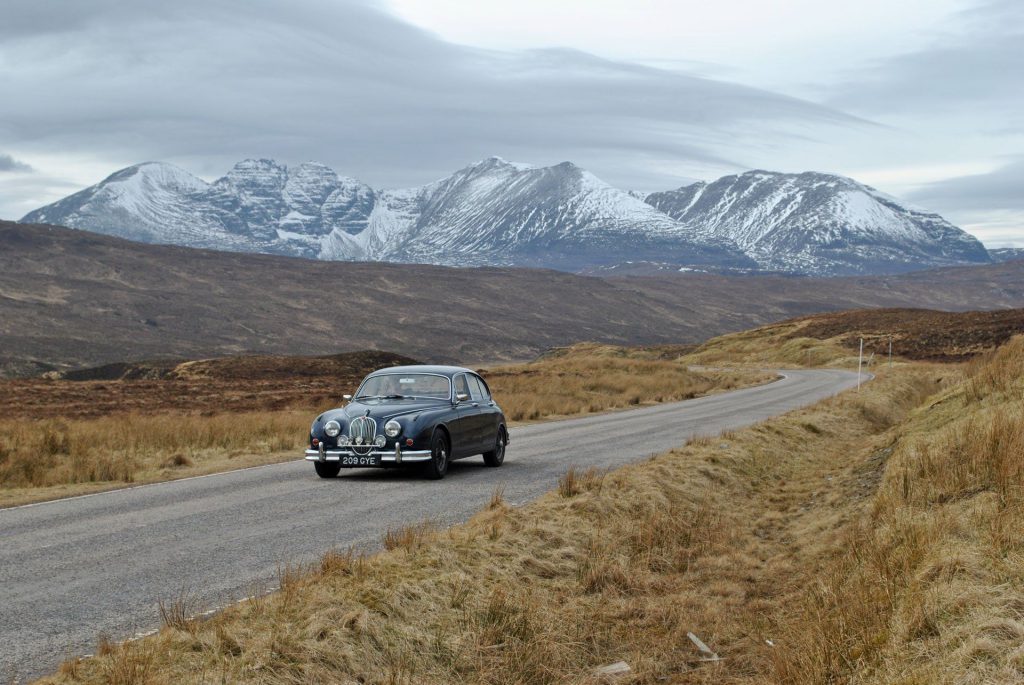
The coast cannot support a road along its full, tortuous length and so our route frequently dipped inland following the darkly named Destitution Road, not due to the undeniably desolate scenery but to the hardship of the men who built the road in return for food rations, being constructed around 1850 at the time of the potato famines, well-documented in Ireland but also afflicting the Highlands.
We spent the night in a charming wooden chalet overlooking Ardmair Bay north of Ullapool.
Our chosen route deviated from that of the NC500 as we explored Coigach and took in spectacular vistas before reaching Lochinver. Heading back inland we traversed high ground beneath a curious mountain named Quinag, often compared to an upturned milking stool. Beyond, the shattered coastline led us to Durness where it turns abruptly east having run out of dry land. The next stage was to drive along the north coast from corner to corner but before arriving at the landmark point of John O’Groats. We detoured to Dunnet Head, which is the actual most northerly point on the British mainland and bristling with stupendous sea cliffs. John O’Groats receives all the acclaim, rather unjustly perhaps, simply as it happens to occupy the top right hand corner of the map. My advice is to visit the famous signpost by all means but do not miss the jagged sea stacks at nearby Duncansby.
An early start for the long day in store began with a brief sortie to the Whaligoe Steps, little-known but fascinating, being a staircase hewn from a near vertical cliff. We continued south crossing the great firths of Dornoch, Cromarty and Beauly (all now bridged saving much time on the previous tortuous coastal route) and then bypassed the City of Inverness on a dual carriageway. This is where the NC500 concludes.
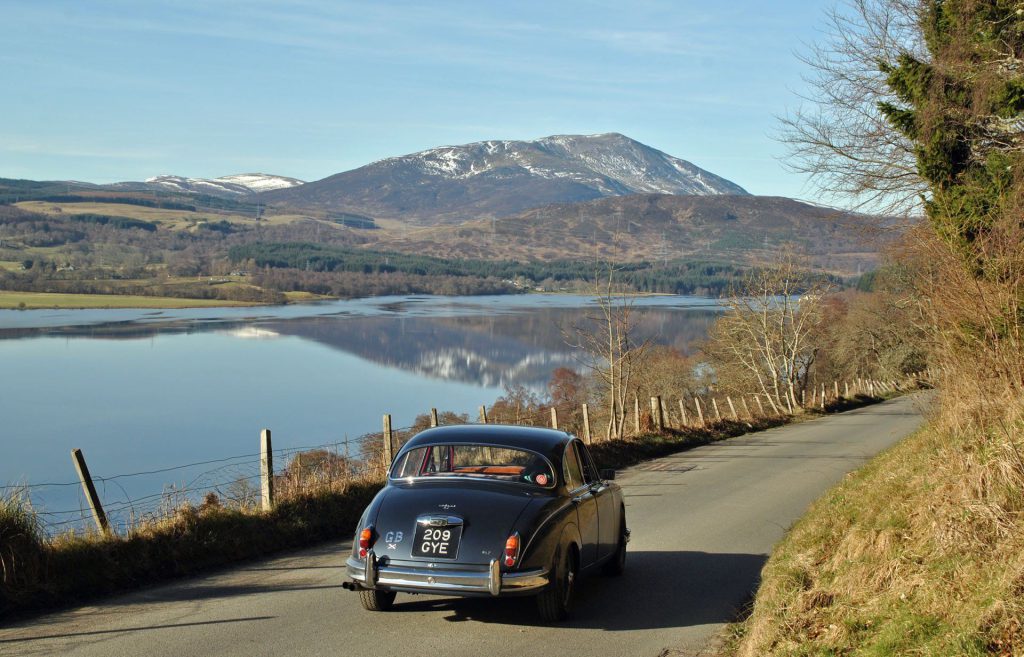
A diversion to Culloden Battlefield offered a light breeze to temper the late March heatwave (yes seriously!) and from there we were bound for the Cairngorm massif, the highest concentrated land mass in Britain whose generally arctic climate was banished by the spring heat. The high passes of the Lecht and Cairnwell (the highest classified roads in Britain) both serve as skiing areas, although with balmy temperatures and little snow the normal skiing season had come to an abrupt halt. A long day drew to a close at Pitlochry with a very comfortable hotel, chosen as a treat for our final night in the Highlands.
The following morning was again blissfully cloudless and the Mk2 on song as we embraced the Perthshire Mountains tracking westwards to the Trossachs, which form part of the national park shared with Loch Lomond. And as the Loch came into view so did the realisation that our Highland sojourn was suddenly over, marked by the sight of Balloch pier, a witness to our departure in sub-zero temperatures and return amidst unseasonable warmth, in the space of just…one thousand miles!
HIGHLAND ONE THOUSAND
START/FINISH: BALLOCH PIER, LOCH LOMOND (Mileages are approximate)
| Miles | |
|---|---|
| 0 | BALLOCH PIER – A82 LUSS/TARBET – A83 ARROCHAR |
| 20 | ARROCHAR – INVERARAY – A819/A85 DALMALLY |
| 57 | DALMALLY – B8074 GLEN ORCHY – BRIDGE OF ORCHY – A82 GLENCOE |
| 93 | GLENCOE – B863 KINLOCHLEVEN/NORTH BALLACHULISH – A82 FORT WILLIAM |
| 121 | FORT WILLIAM – BANAVIE B8004 GAIRLOCHY/COMMANDO MEMORIAL – A82 INVERGARRY – A87 KYLE OF LOCHALSH / BROADFORD (SKYE) |
| OR FORTWILLIAM – MALLAIG – FERRY TO ARMADALE – BROADFORD (minus 20 MILES) | |
| 206 | BROADFORD – SLIGACHAN – A683 DUNVEGAN A850 – TOTE – A87 UIG |
| 271 | A855 UIG – DUNTULM – STAFFIN – DIVERSION TO QUIRAING – PORTREE |
| 309 | PORTREE – A87 SLIGACHAN – BROADFORD – KYLE OF LOCHALSH |
| 344 | KYLE OF LOCHALSH – (Unclassifed) PLOCKTON – A890 STRATHCARRON |
| 361 | STRATHCARRON – A896 LOCHCARRON – KISHORN – (Unclassified) APPLECROSS |
| 379 | APPLECROSS – FEARNMORE -SHIELDAIG – A896 KINLOCHEWE |
| 419 | KINLOCHEWE – A832 GAIRLOCH/BREAMORE JUNCTION – A835 ULLAPOOL |
| 492 | ULLAPOOL – (Unclassified) LOCH LURGAINN/INVERKIRKAIG – LOCHINVER – A837 ARDVRECK – A894 SCOURIE |
| 553 | SCOURIE – A838 TONGUE |
| 610 | TONGUE – A836 THURSO |
| 654 | THURSO – JOHN O’ GROATS VIA B855 DUNNET HEAD |
| 677 | JOHN O’ GROATS – VIA DUNCANSBY – A99 WICK/ A9 DORNOCH VIA SKELBO |
| 760 | DORNOCH – INVERNESS |
| 806 | INVERNESS – B9006 CULLODEN – B851/A9 CARRBRIDGE – A938 GRANTOWN ON SPEY- A939 TOMINTOUL |
| 852 | TOMINTOUL – B896 CRATHIE – A93 BRAEMAR |
| 884 | BRAEMAR – GLEN SHEE – B950/A924 PITLOCHRY |
| 922 | PITLOCHRY – B8019 QUEEN’S VIEW – B846 KENMORE – A827 LOCHEARNHEAD |
| 973 | LOCHEARNHEAD – A84 KILMAHOG – A821 TROSSACHS PIER – DUKE’S PASS – ABERFOYLE |
| 1002 | ABERFOYLE – A81 DRYMEN – A811 BALLOCH PIER |
| 1021 | BALLOCH PIER |
RECOMMENDED DIVERSIONS:
DALMALLY –DUNCAN MACINTYRE VIEWPOINT (Return) + 2 MILES
FORT WILLIAM TO GLEN NEVIS, Lower Steall Falls (Return) + 10 MILES
BROADFORD TO ELGOL (Return) + 28 MILES
DORNOCH – INVERNESS VIA BLACK ISLE COAST B9163 CROMARTY – A832 MUNLOCHY + 25 MILES
BRAEMAR TO LINN OF DEE (Return) + 12 MILES
RECOMMENDED PLACES OF INTEREST:
In route order – please refer to guidebooks/internet for further details.
Luss; Inveraray; Glencoe NTS Visitor Centre; Neptune’s Staircase, Banavie; Commando Memorial (Spean Bridge); Eilean Donan Castle; Corrieshalloch Gorge (near Ullapool); Plockton
Sango Sands/Smoo Cave (Durness); Dunnet Head; Stacks of Duncansby
Whaligoe Steps (Ulbster); Dunrobin Castle (gardens & falconry show)
Culloden Battlefield; Crathie Church; Balmoral Castle
A detailed road map is indispensable and do plenty of research into places of interest before travelling!
In: